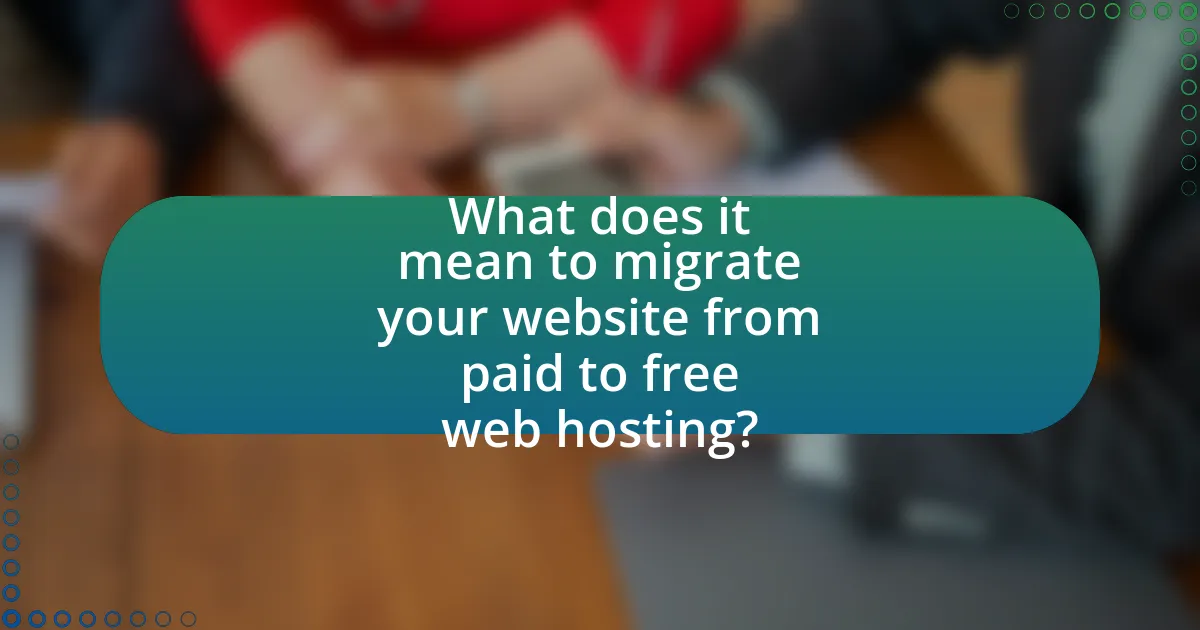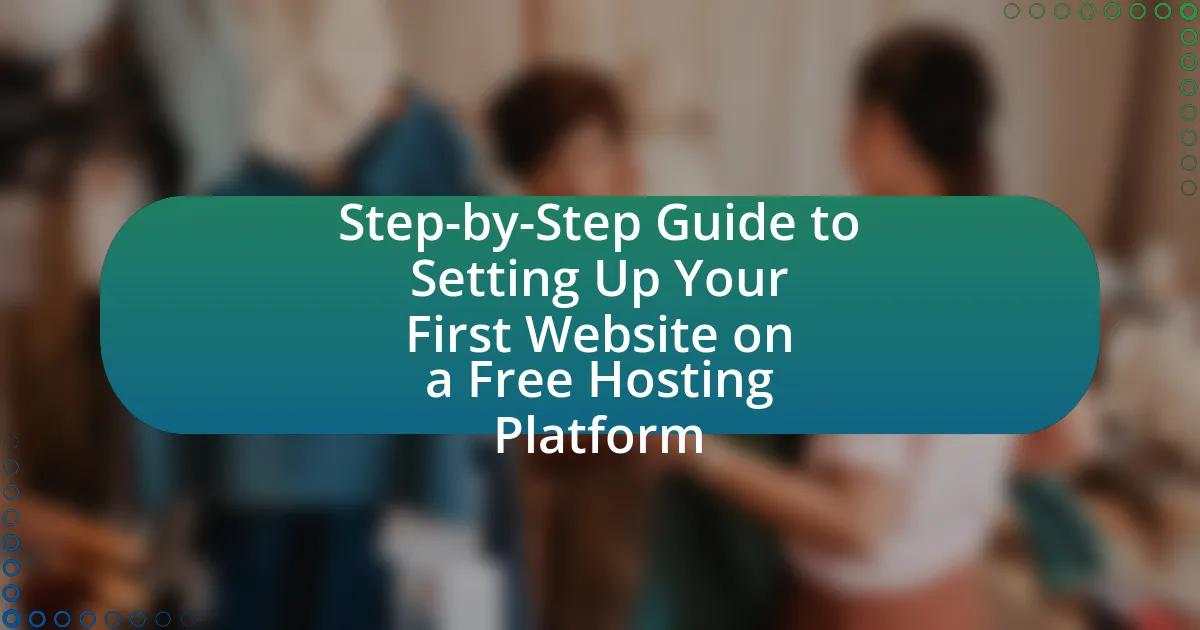Migrating a website from paid to free web hosting involves transferring files, databases, and configurations while ensuring compatibility with the new hosting service. This article outlines the reasons for such a migration, including cost savings and ease of access, while also addressing potential challenges like data loss and downtime. Key steps in the migration process are detailed, including planning, backing up data, and testing the new environment. Additionally, best practices for ensuring data integrity and avoiding common pitfalls are discussed, along with specific considerations for different types of websites, such as e-commerce and blogs. Tools and resources available for a successful migration are also highlighted, providing a comprehensive guide for users looking to make this transition effectively.

What does it mean to migrate your website from paid to free web hosting?
Migrating your website from paid to free web hosting means transferring your website’s files, databases, and configurations from a paid hosting service to a free hosting service. This process typically involves backing up your website data, setting up an account with the free hosting provider, and then uploading your website files to the new server. It is essential to ensure that the free hosting service supports the technologies your website uses, as limitations in resources or features may affect website performance and functionality.
Why would someone consider migrating to free web hosting?
Someone would consider migrating to free web hosting primarily to reduce costs associated with website maintenance. Free web hosting services eliminate monthly fees, making them an attractive option for individuals or small businesses with limited budgets. Additionally, many free hosting providers offer essential features such as website builders, basic storage, and bandwidth, which can be sufficient for personal projects or small-scale websites. According to a survey by HostingAdvice, 70% of users cite cost as the primary reason for choosing free hosting options.
What are the potential benefits of free web hosting?
Free web hosting offers several potential benefits, including cost savings, ease of access, and basic functionality for small projects. Users can save money by avoiding hosting fees, making it an attractive option for individuals or startups with limited budgets. Additionally, free web hosting services often provide user-friendly interfaces and simple setup processes, allowing users to quickly launch their websites without extensive technical knowledge. Many free hosting providers also include essential features such as website builders, templates, and basic customer support, which can facilitate the creation and management of a website.
What challenges might arise during the migration process?
During the migration process from paid to free web hosting, several challenges may arise, including data loss, downtime, and compatibility issues. Data loss can occur if backups are not properly managed or if files are corrupted during transfer. Downtime may happen due to DNS propagation delays or server configuration errors, leading to accessibility issues for users. Compatibility issues can arise if the free hosting service does not support certain features or technologies used by the website, potentially resulting in functionality problems. These challenges highlight the importance of thorough planning and testing during the migration process to ensure a smooth transition.
What are the key steps involved in the migration process?
The key steps involved in the migration process from paid to free web hosting include planning, backing up data, selecting a new hosting provider, transferring files, updating DNS settings, and testing the website.
Planning involves assessing the current website’s requirements and ensuring the free hosting service can meet them. Backing up data is crucial to prevent data loss; this includes files, databases, and configurations. Selecting a new hosting provider requires comparing features, limitations, and support options of various free hosting services. Transferring files entails moving website content to the new host, which can be done via FTP or a control panel. Updating DNS settings is necessary to point the domain to the new hosting server, ensuring visitors reach the correct site. Finally, testing the website after migration confirms that all functionalities work correctly and that no data has been lost during the process.
How do you prepare your website for migration?
To prepare your website for migration, first, conduct a comprehensive backup of all website files and databases. This ensures that you have a complete copy of your site, which is crucial for restoring it in case of any issues during the migration process. According to a study by the Web Hosting Industry Review, 70% of website owners who fail to back up their sites experience data loss during migration. Next, document your current website settings, including DNS records, email configurations, and any custom scripts. This documentation will facilitate a smoother transition to the new hosting environment. Additionally, test the new hosting environment by uploading a copy of your website to ensure compatibility and performance before the final migration.
What tools can assist in the migration process?
Tools that can assist in the migration process include website migration plugins, FTP clients, and backup solutions. Website migration plugins, such as Duplicator and All-in-One WP Migration, streamline the transfer of files and databases, ensuring a seamless transition. FTP clients like FileZilla facilitate the transfer of files between the local system and the web server, allowing for efficient management of website content. Backup solutions, such as UpdraftPlus, provide a safety net by creating copies of the website data, which can be restored if any issues arise during migration. These tools are essential for minimizing downtime and preventing data loss during the migration from paid to free web hosting.

How can you ensure data integrity during the migration?
To ensure data integrity during migration, implement a comprehensive backup strategy before initiating the process. This involves creating full backups of all website files and databases, which can be verified for completeness and accuracy. Additionally, utilize checksums or hash functions to compare the original data with the migrated data, ensuring that no corruption or loss occurs during the transfer. According to a study by the International Journal of Information Management, data loss during migration can be minimized by 70% when proper verification methods are employed.
What precautions should you take to avoid data loss?
To avoid data loss during the migration of your website from paid to free web hosting, regularly back up your data. This includes files, databases, and configurations, ensuring that you have multiple copies stored in different locations, such as external drives or cloud storage. According to a study by the University of Maryland, 93% of companies that experience a significant data loss for more than ten days file for bankruptcy within a year, highlighting the critical importance of backups. Additionally, verify the integrity of your backups before initiating the migration process to ensure that all data is intact and usable.
How can you back up your website effectively?
To back up your website effectively, utilize a combination of automated backup solutions and manual methods. Automated backup solutions, such as plugins for content management systems like WordPress, can schedule regular backups, ensuring that your data is consistently saved without manual intervention. For instance, plugins like UpdraftPlus or BackupBuddy can create complete backups of your files and database, storing them in cloud services like Google Drive or Dropbox.
In addition to automated backups, manually exporting your website’s database and files provides an extra layer of security. For example, using phpMyAdmin, you can export your database as an SQL file, while FTP clients like FileZilla allow you to download all website files to your local storage. This dual approach ensures that you have multiple copies of your data, reducing the risk of loss during migration from paid to free web hosting.
What methods can you use to verify data integrity post-migration?
To verify data integrity post-migration, you can use methods such as checksum validation, data comparison, and automated testing. Checksum validation involves generating a hash value for the data before and after migration, ensuring that both values match, which confirms data integrity. Data comparison entails comparing the source and destination datasets to identify discrepancies, ensuring that all records have been accurately transferred. Automated testing can include scripts that validate data formats, relationships, and constraints, further ensuring that the migrated data adheres to the expected structure and quality. These methods are effective in confirming that the data remains intact and unaltered throughout the migration process.
What common pitfalls should you avoid during migration?
Common pitfalls to avoid during migration include inadequate planning, which can lead to data loss or downtime. Failing to create a comprehensive backup of all website data before migration increases the risk of losing critical information. Additionally, neglecting to test the new hosting environment prior to the full migration can result in compatibility issues that disrupt website functionality. Not updating DNS settings promptly can cause prolonged downtime, as users may still be directed to the old server. Lastly, overlooking the need for proper SEO adjustments can negatively impact search engine rankings post-migration. These pitfalls are well-documented in migration case studies, emphasizing the importance of thorough preparation and execution.
How can you prevent downtime during the transition?
To prevent downtime during the transition from paid to free web hosting, implement a phased migration strategy. This involves setting up the new hosting environment while the existing site remains operational, allowing for testing and adjustments without affecting the live site. According to a study by Google, sites that experience downtime can lose up to 20% of their traffic, emphasizing the importance of a seamless transition. By using techniques such as DNS propagation management and maintaining a backup of the original site, you can ensure that users experience minimal disruption during the migration process.
What are the risks of not testing your website after migration?
Not testing your website after migration poses significant risks, including broken links, functionality issues, and loss of data integrity. Broken links can lead to a poor user experience and negatively impact search engine rankings, as search engines prioritize sites that are fully operational. Functionality issues may arise from incompatibilities between the old and new hosting environments, potentially causing features to malfunction or not work at all. Additionally, without testing, there is a risk of data loss or corruption, which can result in the loss of critical information and user trust. These risks highlight the importance of thorough testing to ensure a seamless transition and maintain website performance.

What are the specific considerations for different types of websites?
Different types of websites require specific considerations during migration to ensure data integrity and functionality. For example, e-commerce websites must prioritize secure payment processing and data protection, as losing customer information can lead to significant financial loss and legal issues. Content-based websites, such as blogs or news sites, should focus on maintaining SEO rankings and ensuring that all links and media files are correctly redirected to avoid traffic loss. Portfolio websites need to ensure that visual elements are preserved and displayed correctly, as these are crucial for showcasing work. Lastly, membership or community sites must consider user account data and access permissions to maintain user experience and engagement. Each type of website has unique requirements that must be addressed to facilitate a smooth transition from paid to free hosting without data loss.
How does the migration process differ for static vs. dynamic websites?
The migration process for static websites differs from that of dynamic websites primarily in complexity and data handling. Static websites consist of fixed content, making their migration straightforward; files can be transferred directly to the new hosting environment without the need for database management. In contrast, dynamic websites rely on server-side scripts and databases to generate content, necessitating careful migration of both the files and the associated database to ensure functionality. For example, a static site may only require FTP access to upload HTML files, while a dynamic site may require exporting and importing databases, adjusting configuration files, and ensuring that server-side scripts are compatible with the new hosting environment.
What unique challenges do e-commerce websites face during migration?
E-commerce websites face several unique challenges during migration, primarily related to data integrity, downtime, and SEO impact. Data integrity is crucial as migrating product information, customer data, and transaction history must be executed flawlessly to avoid loss or corruption. Downtime poses a significant risk; any extended period without access can lead to lost sales and customer dissatisfaction. Additionally, SEO impact is a concern, as changes in URLs or site structure can negatively affect search engine rankings if not managed properly. According to a study by Moz, 70% of e-commerce sites experience a drop in traffic post-migration due to improper handling of redirects and metadata. These challenges necessitate careful planning and execution to ensure a successful migration without compromising the website’s functionality or performance.
How can blogs and content-heavy sites manage their migration effectively?
Blogs and content-heavy sites can manage their migration effectively by implementing a comprehensive plan that includes data backup, URL mapping, and testing. First, creating a complete backup of all content, databases, and configurations ensures that no data is lost during the transition. According to a study by the Content Marketing Institute, 70% of marketers believe that content is essential for their business, highlighting the importance of preserving it during migration.
Next, establishing a URL mapping strategy helps maintain SEO rankings by redirecting old URLs to new ones, which is crucial since 93% of online experiences begin with a search engine, as reported by Search Engine Journal. Finally, conducting thorough testing post-migration ensures that all functionalities work correctly and that the user experience remains intact. This structured approach minimizes risks and enhances the likelihood of a successful migration.
What are the best practices for a successful migration?
The best practices for a successful migration from paid to free web hosting include thorough planning, data backup, and testing. First, planning involves creating a detailed migration strategy that outlines the steps, timeline, and resources needed for the transition. Data backup is crucial; it ensures that all website files, databases, and configurations are securely saved before initiating the migration process. Testing the new environment after migration is essential to verify that all functionalities work correctly and that no data is lost. According to a study by the Web Hosting Industry Review, 70% of website migrations fail due to inadequate planning and testing, highlighting the importance of these best practices.
How can you create a detailed migration plan?
To create a detailed migration plan, first identify all components of your website, including files, databases, and configurations. Next, outline the steps for transferring these components from the paid hosting environment to the free hosting platform, ensuring to include backup procedures for data integrity. Additionally, establish a timeline for each phase of the migration, including testing and validation of the new setup. It is essential to document potential risks and mitigation strategies to address any issues that may arise during the migration process. This structured approach ensures a smooth transition while minimizing the risk of data loss.
What ongoing maintenance should you consider after migration?
After migration, ongoing maintenance should include regular backups, performance monitoring, and security updates. Regular backups ensure that data can be restored in case of loss, while performance monitoring helps identify issues that could affect user experience, such as slow loading times. Security updates are crucial to protect the website from vulnerabilities, especially on free hosting platforms that may have fewer built-in security measures. According to a study by the Ponemon Institute, 60% of small businesses that experience a data breach go out of business within six months, highlighting the importance of these maintenance practices.
What troubleshooting tips can help during the migration process?
During the migration process, verifying backups is crucial to ensure data integrity. This involves creating complete backups of all website files and databases before initiating the migration. Additionally, checking compatibility between the old and new hosting environments can prevent issues; for example, ensuring that the new host supports the same programming languages and database systems. Monitoring DNS propagation is also important, as it can take time for changes to reflect globally, which may lead to temporary downtime. Lastly, testing the website functionality on the new host before fully switching over can help identify and resolve any issues early, ensuring a smoother transition.
How can you address common issues that arise during migration?
To address common issues that arise during migration, implement a comprehensive backup strategy prior to the migration process. This ensures that all website data, including files and databases, are securely stored and can be restored if any issues occur during the transition. According to a study by the Web Hosting Industry Review, 70% of website migrations experience data loss or downtime due to inadequate preparation. By conducting thorough testing in a staging environment before the actual migration, you can identify potential problems and resolve them proactively, minimizing the risk of disruption.
What resources are available for additional support during migration?
During migration from paid to free web hosting, various resources are available for additional support, including online forums, documentation from hosting providers, and migration tools. Online forums such as Stack Overflow and Reddit offer community-driven advice and troubleshooting tips. Documentation from hosting providers typically includes step-by-step guides and FAQs tailored to their specific platforms. Additionally, migration tools like Duplicator and All-in-One WP Migration facilitate the transfer process by automating data migration, ensuring that users can move their websites without losing data. These resources collectively enhance the migration experience by providing essential guidance and tools.




